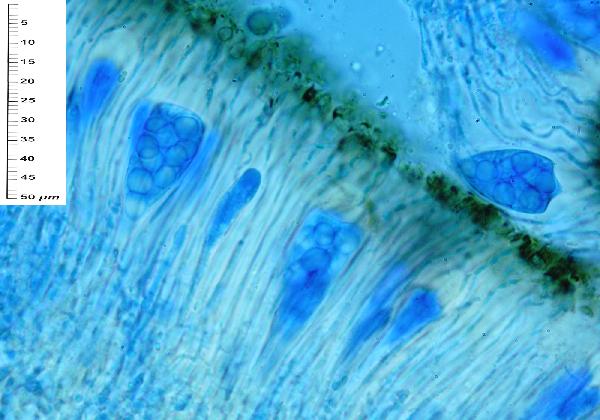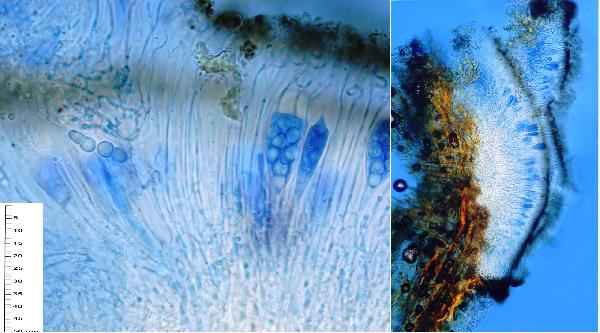Melaspilea enteroleuca (Ach.) Ertz & Diederich
Fungal Divers., 71: 151, 2015. Basionym: Lecidea enteroleuca Ach. - Lich.Univ.: 177, 1810.
Synonyms: Abrothallus ricasolii A. Massal.; Buellia ricasolii (A. Massal.) A. Massal.; Buellia ricasolii var. hysteroides A. Massal.; Catillaria ricasolii (A. Massal.) A. Massal.; Lecidea sparsa Dufour; Melaspilea arthonioides auct. non (Fée) Nyl.; Melaspilea urceolata auct. eur. non (Fr.) Ertz & Diederich; Poetschia arthonioides auct. non (Fée) Stein
Distribution: N - VG (Tretiach & Carvalho 1995), Frl, Ven (Lazzarin 2000), TAA (Nascimbene & al. 2007b, 2022), Lomb, Piem (Giordani & al. 2025), Emil (Gasparo & Tretiach 1996, Fariselli & al. 2020), Lig (Giordani & al. 2025). C - Tosc (Loppi & Frati 2006, Lazzarin 2000), Marc (Nimis & Tretiach 1999, Frati & al. 2004, Frati & Brunialti 2006), Laz (TSB 26112), Abr (Recchia & al. 1993, Gheza & al. 2021), Sar. S - Camp, Pugl (Nimis & Tretiach 1999), Si.
Description: Thallus crustose, episubstratic, very thin but well-evident, smooth, white to pale grey. Apothecia rounded, 0.5-2 mm across, with a black, flat to moderately convex, rarely slightly pruinose disc and a thin, at first slightly emergent, but often finally excluded proper margin. Exciple thin, dark brown to almost black; epithecium brown; hymenium colourless, not amyloid; paraphyses thread-like, simple or sparingly branched; hypothecium colourless to very pale brown. Asci 8-spored, elongate-clavate, thickened at apex and with an internal apical beak, K/I-. Ascospores 1-septate, slightly constricted at septum and with unequal cells, long remaining hyaline, finally brown, 10-18 x 5-11 µm. Pycnidia black. Conidia simple, hyaline, ellipsoid, 8-10 x 4-5 µm. Photobiont trentepohlioid. Spot tests: thallus K-, C-, KC-, P-, UV-. Chemistry: without lichen substances. Note: a mild-temperate species found on hard bark of deciduous trees (Quercus, Morus, etc.); more widespread in the past, presently declining. Following Ertz & Diederich (2015), I have placed here all Italian records of M. urceolata and M. arthonioides, which are two different, American species. It is included in the Italian red list of epiphytic lichens as “Near-threatened” (Nascimbene & al. 2013c).
Growth form: Crustose
Substrata: bark
Photobiont: Trentepohlia
Reproductive strategy: mainly sexual
Most common in areas with a humid-warm climate (e.g. most of Tyrrenian Italy)
Commonnes-rarity: (info)
Alpine belt: absent
Subalpine belt: absent
Oromediterranean belt: absent
Montane belt: absent
Submediterranean belt: extremely rare
Padanian area: absent
Humid submediterranean belt: very rare
Humid mediterranean belt: extremely rare
Dry mediterranean belt: absent

Predictive model
Herbarium samples


Felix Schumm; Owner: CC BY-SA 4.0
[TSB_17674], Italia, Lazio, Selva del Lamone, (Prov. Viterbo), c. 500 m, on Quercus petraea. Leg. et det. M. Tretiach, 19-26.08.1993


P.L. Nimis; Owner: Department of Life Sciences, University of Trieste
Herbarium: TSB (17674)
2001/12/09


P.L. Nimis; Owner: Department of Life Sciences, University of Trieste
Herbarium: TSB (17674)
2001/12/09
apothecium


Felix Schumm; Owner: CC BY-SA 4.0
[TSB_17674], Italia, Lazio, Selva del Lamone, (Prov. Viterbo), c. 500 m, on Quercus petraea. Leg. et det. M. Tretiach, 19-26.08.1993


Felix Schumm; Owner: CC BY-SA 4.0
[TSB_17674], Italia, Lazio, Selva del Lamone, (Prov. Viterbo), c. 500 m, on Quercus petraea. Leg. et det. M. Tretiach, 19-26.08.1993


Felix Schumm - CC BY-SA 4.0
[TSB_17674], Italia, Lazio, Selva del Lamone, (Prov. Viterbo), c. 500 m, on Quercus petraea. Leg. et det. M. Tretiach, 19-26.08.1993


Felix Schumm - CC BY-SA 4.0
[TSB_17674], Italia, Lazio, Selva del Lamone, (Prov. Viterbo), c. 500 m, on Quercus petraea. Leg. et det. M. Tretiach, 19-26.08.1993


Felix Schumm - CC BY-SA 4.0
[TSB_17674], Italia, Lazio, Selva del Lamone, (Prov. Viterbo), c. 500 m, on Quercus petraea. Leg. et det. M. Tretiach, 19-26.08.1993


Felix Schumm - CC BY-SA 4.0
[TSB_17674], Italia, Lazio, Selva del Lamone, (Prov. Viterbo), c. 500 m, on Quercus petraea. Leg. et det. M. Tretiach, 19-26.08.1993


Felix Schumm - CC BY-SA 4.0
[TSB_17674], Italia, Lazio, Selva del Lamone, (Prov. Viterbo), c. 500 m, on Quercus petraea. Leg. et det. M. Tretiach, 19-26.08.1993
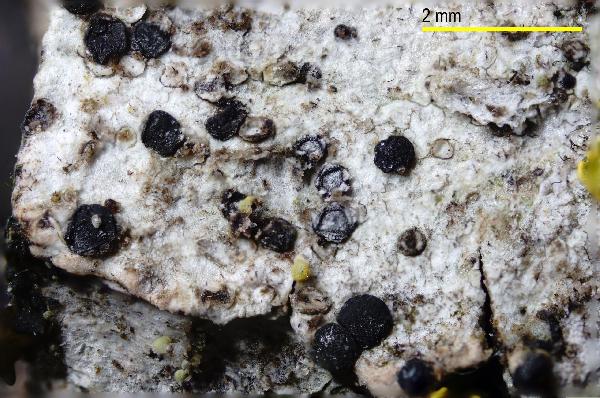
Marta González - Centro de EStudios Micologicos Asturianos
Bejes (Cantabria), 9-VII-2024, en corteza de Juglans regia, a 580 m de altitud, leg. & det. M. González.
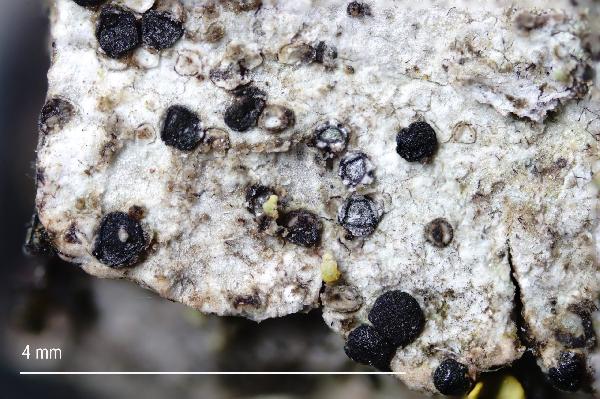
Marta González - Centro de EStudios Micologicos Asturianos
Bejes (Cantabria), 9-VII-2024, en corteza de Juglans regia, a 580 m de altitud, leg. & det. M. González.
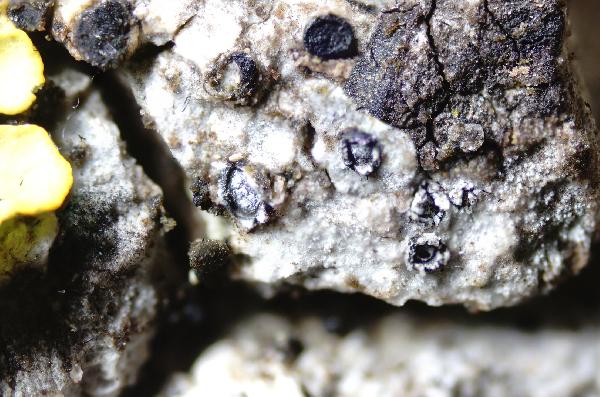
Marta González - Centro de EStudios Micologicos Asturianos
Bejes (Cantabria), 9-VII-2024, en corteza de Juglans regia, a 580 m de altitud, leg. & det. M. González.

Marta González - Centro de EStudios Micologicos Asturianos
Bejes (Cantabria), 9-VII-2024, en corteza de Juglans regia, a 580 m de altitud, leg. & det. M. González.
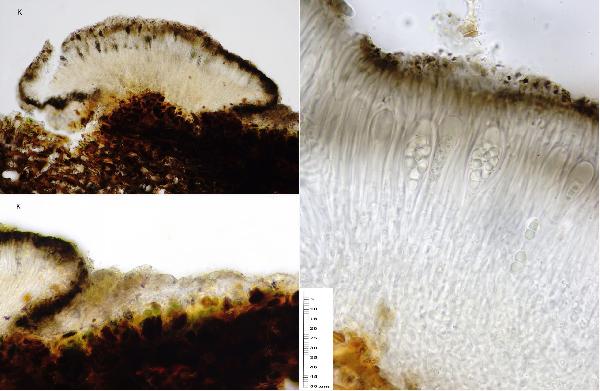
Marta González - Centro de EStudios Micologicos Asturianos
Bejes (Cantabria), 9-VII-2024, en corteza de Juglans regia, a 580 m de altitud, leg. & det. M. González.
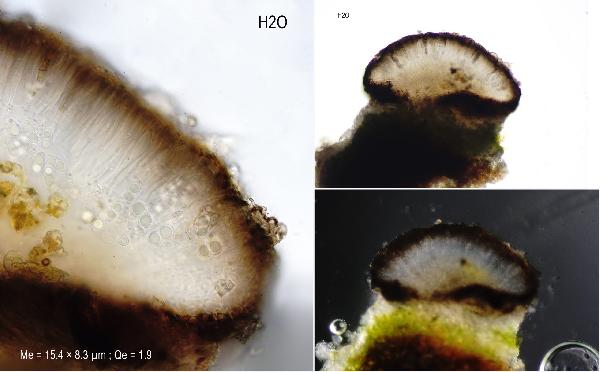
Marta González - Centro de EStudios Micologicos Asturianos
Bejes (Cantabria), 9-VII-2024, en corteza de Juglans regia, a 580 m de altitud, leg. & det. M. González.
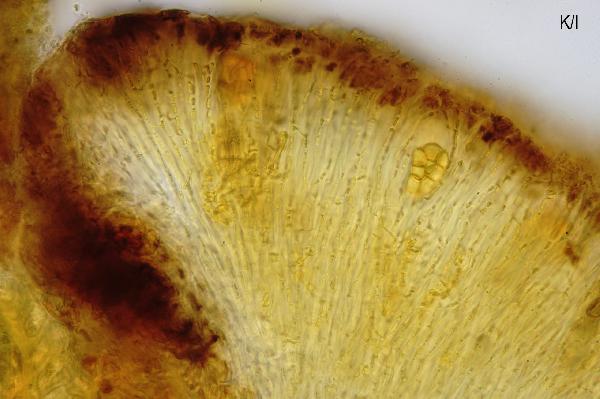
Marta González - Centro de EStudios Micologicos Asturianos
Bejes (Cantabria), 9-VII-2024, en corteza de Juglans regia, a 580 m de altitud, leg. & det. M. González.
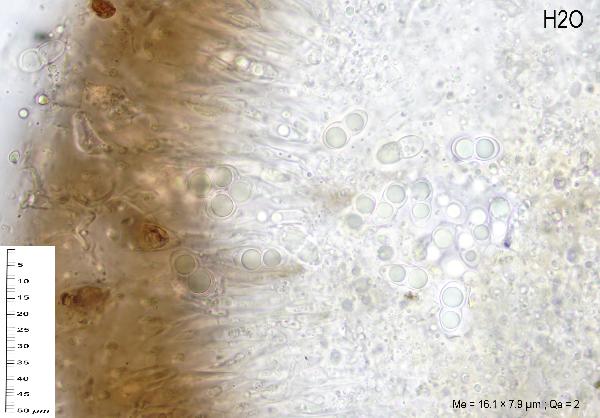
Marta González - Centro de EStudios Micologicos Asturianos
Bejes (Cantabria), 9-VII-2024, en corteza de Juglans regia, a 580 m de altitud, leg. & det. M. González.
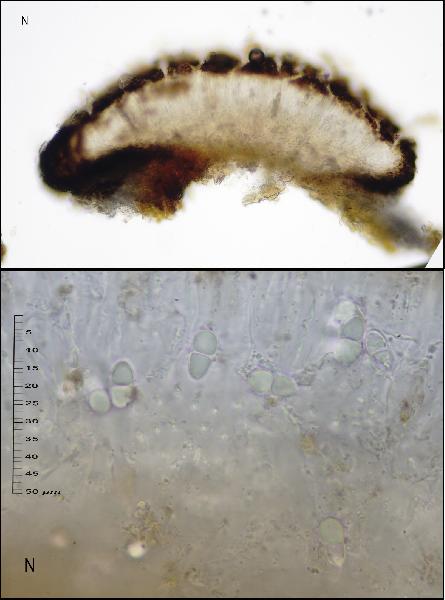
Marta González - Centro de EStudios Micologicos Asturianos
Bejes (Cantabria), 9-VII-2024, en corteza de Juglans regia, a 580 m de altitud, leg. & det. M. González.
Growth form: Crustose
Substrata: bark
Photobiont: Trentepohlia
Reproductive strategy: mainly sexual
Most common in areas with a humid-warm climate (e.g. most of Tyrrenian Italy)
Commonnes-rarity: (info)
Alpine belt: absent
Subalpine belt: absent
Oromediterranean belt: absent
Montane belt: absent
Submediterranean belt: extremely rare
Padanian area: absent
Humid submediterranean belt: very rare
Humid mediterranean belt: extremely rare
Dry mediterranean belt: absent

Predictive model
| Herbarium samples |


Felix Schumm; Owner: CC BY-SA 4.0
[TSB_17674], Italia, Lazio, Selva del Lamone, (Prov. Viterbo), c. 500 m, on Quercus petraea. Leg. et det. M. Tretiach, 19-26.08.1993


P.L. Nimis; Owner: Department of Life Sciences, University of Trieste
Herbarium: TSB (17674)
2001/12/09


P.L. Nimis; Owner: Department of Life Sciences, University of Trieste
Herbarium: TSB (17674)
2001/12/09
apothecium


Felix Schumm; Owner: CC BY-SA 4.0
[TSB_17674], Italia, Lazio, Selva del Lamone, (Prov. Viterbo), c. 500 m, on Quercus petraea. Leg. et det. M. Tretiach, 19-26.08.1993


Felix Schumm; Owner: CC BY-SA 4.0
[TSB_17674], Italia, Lazio, Selva del Lamone, (Prov. Viterbo), c. 500 m, on Quercus petraea. Leg. et det. M. Tretiach, 19-26.08.1993


Felix Schumm - CC BY-SA 4.0
[TSB_17674], Italia, Lazio, Selva del Lamone, (Prov. Viterbo), c. 500 m, on Quercus petraea. Leg. et det. M. Tretiach, 19-26.08.1993


Felix Schumm - CC BY-SA 4.0
[TSB_17674], Italia, Lazio, Selva del Lamone, (Prov. Viterbo), c. 500 m, on Quercus petraea. Leg. et det. M. Tretiach, 19-26.08.1993


Felix Schumm - CC BY-SA 4.0
[TSB_17674], Italia, Lazio, Selva del Lamone, (Prov. Viterbo), c. 500 m, on Quercus petraea. Leg. et det. M. Tretiach, 19-26.08.1993


Felix Schumm - CC BY-SA 4.0
[TSB_17674], Italia, Lazio, Selva del Lamone, (Prov. Viterbo), c. 500 m, on Quercus petraea. Leg. et det. M. Tretiach, 19-26.08.1993


Felix Schumm - CC BY-SA 4.0
[TSB_17674], Italia, Lazio, Selva del Lamone, (Prov. Viterbo), c. 500 m, on Quercus petraea. Leg. et det. M. Tretiach, 19-26.08.1993

Marta González - Centro de EStudios Micologicos Asturianos
Bejes (Cantabria), 9-VII-2024, en corteza de Juglans regia, a 580 m de altitud, leg. & det. M. González.

Marta González - Centro de EStudios Micologicos Asturianos
Bejes (Cantabria), 9-VII-2024, en corteza de Juglans regia, a 580 m de altitud, leg. & det. M. González.

Marta González - Centro de EStudios Micologicos Asturianos
Bejes (Cantabria), 9-VII-2024, en corteza de Juglans regia, a 580 m de altitud, leg. & det. M. González.

Marta González - Centro de EStudios Micologicos Asturianos
Bejes (Cantabria), 9-VII-2024, en corteza de Juglans regia, a 580 m de altitud, leg. & det. M. González.

Marta González - Centro de EStudios Micologicos Asturianos
Bejes (Cantabria), 9-VII-2024, en corteza de Juglans regia, a 580 m de altitud, leg. & det. M. González.

Marta González - Centro de EStudios Micologicos Asturianos
Bejes (Cantabria), 9-VII-2024, en corteza de Juglans regia, a 580 m de altitud, leg. & det. M. González.

Marta González - Centro de EStudios Micologicos Asturianos
Bejes (Cantabria), 9-VII-2024, en corteza de Juglans regia, a 580 m de altitud, leg. & det. M. González.

Marta González - Centro de EStudios Micologicos Asturianos
Bejes (Cantabria), 9-VII-2024, en corteza de Juglans regia, a 580 m de altitud, leg. & det. M. González.

 INDEX FUNGORUM
INDEX FUNGORUM
 GBIF
GBIF
 DOLICHENS
DOLICHENS

